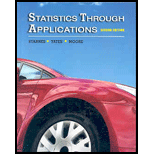
Concept explainers
(a)
To Explain: the randomization important in this study.
(a)
Answer to Problem 10.30E
To exclude the effect of any lurking variables
Explanation of Solution
Given:
| No subsequent arrest | Subsequent arrest | |
| Advise and separate | 187 | 25 |
| Citation | 181 | 43 |
| Arrest | 175 | 39 |
Assume:
Randomization are very important such that the results of being arrested or not is unaffected by any lurking variables. A lurking variable is a variable that has a very important effect on the relationship among the variables in a study but it is not one of the explanatory variables studied.
(b)
To Explain: that there is sufficient evidence from this study to conclude that the treatment imposed on an abuser is related to the likelihood of the abuser’s subsequent.
(b)
Answer to Problem 10.30E
There is no enough evidence to help the claim that the treatment imposed on an abuser is related to the likelihood of arrest.
Explanation of Solution
Given:
| No subsequent arrest | Subsequent arrest | |
| Advise and separate | 187 | 25 |
| Citation | 181 | 43 |
| Arrest | 175 | 39 |
Formula used:
Calculation:
The null hypothesis statement is that there is no connection between the variables, where the alternative hypothesis statement is that there is a connection between the variable.
The row and column totals are
| No subsequent arrest | Subsequent arrest | Total | |
| Advise and separate | 187 | 25 | 212 |
| Citation | 181 | 43 | 224 |
| Arrest | 175 | 39 | 214 |
| Total | 543 | 107 | 650 |
The value of the test- statistic is then
The degree of freedom is
The P-Value is the probability of getting the value of the test statistic, or a value more extreme or
If the P-value is equal or less than to the significance level, then the alternative hypothesis is accepted and null hypothesis is rejected:
There is no enough evidence to help the claim that the treatment imposed on an abuser is related to the likelihood of arrest.
Chapter 10 Solutions
Statistics Through Applications
Additional Math Textbook Solutions
Introductory Statistics
Introductory Statistics (2nd Edition)
Elementary Statistics
Elementary Statistics Using Excel (6th Edition)
Statistics for Business and Economics (13th Edition)
Elementary Statistics: Picturing the World (7th Edition)
 MATLAB: An Introduction with ApplicationsStatisticsISBN:9781119256830Author:Amos GilatPublisher:John Wiley & Sons Inc
MATLAB: An Introduction with ApplicationsStatisticsISBN:9781119256830Author:Amos GilatPublisher:John Wiley & Sons Inc Probability and Statistics for Engineering and th...StatisticsISBN:9781305251809Author:Jay L. DevorePublisher:Cengage Learning
Probability and Statistics for Engineering and th...StatisticsISBN:9781305251809Author:Jay L. DevorePublisher:Cengage Learning Statistics for The Behavioral Sciences (MindTap C...StatisticsISBN:9781305504912Author:Frederick J Gravetter, Larry B. WallnauPublisher:Cengage Learning
Statistics for The Behavioral Sciences (MindTap C...StatisticsISBN:9781305504912Author:Frederick J Gravetter, Larry B. WallnauPublisher:Cengage Learning Elementary Statistics: Picturing the World (7th E...StatisticsISBN:9780134683416Author:Ron Larson, Betsy FarberPublisher:PEARSON
Elementary Statistics: Picturing the World (7th E...StatisticsISBN:9780134683416Author:Ron Larson, Betsy FarberPublisher:PEARSON The Basic Practice of StatisticsStatisticsISBN:9781319042578Author:David S. Moore, William I. Notz, Michael A. FlignerPublisher:W. H. Freeman
The Basic Practice of StatisticsStatisticsISBN:9781319042578Author:David S. Moore, William I. Notz, Michael A. FlignerPublisher:W. H. Freeman Introduction to the Practice of StatisticsStatisticsISBN:9781319013387Author:David S. Moore, George P. McCabe, Bruce A. CraigPublisher:W. H. Freeman
Introduction to the Practice of StatisticsStatisticsISBN:9781319013387Author:David S. Moore, George P. McCabe, Bruce A. CraigPublisher:W. H. Freeman





